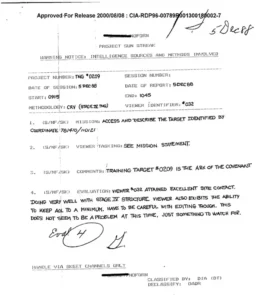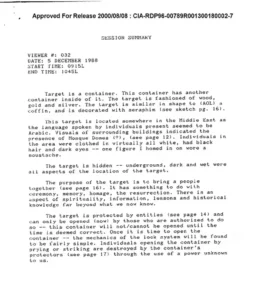Recently resurfaced declassified CIA documents suggest that the intelligence agency once used remote viewing—a form of extrasensory perception (ESP)—to confirm the existence of the Ark of the Covenant. The documents allege that the sacred biblical artifact is safeguarded by mysterious entities with unknown power.

The session, conducted on December 5, 1988, involved a CIA remote viewer, identified as #32, who was unknowingly tasked with locating the Ark. The declassified document, originally released on August 8, 2000, has gained renewed attention after circulating on social media.
Remote Viewing the Ark
Remote viewing involves a participant attempting to “see” a target without any prior knowledge of it. The target’s details are written on a piece of paper, sealed in an envelope, and kept hidden from the remote viewer, who is guided through the process by a separate observer. Joe McMoneagle, a retired U.S. Army Chief Warrant Officer and the CIA’s first remote viewer (#1), explained that only information gathered under these conditions qualifies as true remote viewing.
However, McMoneagle remains skeptical of the 1988 session and its findings.
Details from the Remote Viewing Session
According to the document, remote viewer #32 described a container resembling a coffin, made of wood, gold, and silver, adorned with seraphim. They also reported visuals of mosque domes in the surrounding area and Arabic-speaking men dressed in white, suggesting a Middle Eastern location.

The artifact was said to be hidden underground in a dark and damp environment. Its purpose, according to the remote viewer, was to “bring people together” and was linked to ceremony, memory, homage, and resurrection. The vision also suggested that the Ark held spiritual, informational, and historical knowledge beyond what is currently known.
Supernatural Protection and a Deadly Warning
One of the most striking claims in the document is that the Ark is protected by entities and can only be opened by authorized individuals. The remote viewer warned that any attempt to force the container open could have dire consequences.
“Individuals opening the container by prying or striking are destroyed by the protectors through the use of a power unknown to us,” the document states.
The declassified files also include several drawings, one depicting a seraph standing at the Ark’s corner, while another shows mummies lined up on a wall.
Skepticism from Experts
Despite the sensational claims, Joe McMoneagle dismissed the session’s findings, calling the exercise a waste of time and resources.

“Using remote viewing for targets where no ground truth exists—such as UFOs, UAPs, the surface of Mars, or historical relics—is meaningless,” McMoneagle told The Post.
He argued that remote viewing does not prove the Ark’s existence unless the object is physically located and verified.
“In this case, it’s a training target done on a whim. No one attempted to verify the information, and everything was accepted without evidence,” he added.
McMoneagle, who received the Legion of Merit for using remote viewing to identify a secret Russian warship during the Cold War, emphasized that the Ark remains a legendary artifact with no confirmed modern-day evidence.
“If the Ark is ever produced based on this information, it would be a shock to me and many others,” he concluded.
The Ark of the Covenant, according to biblical tradition, was a sacred chest that housed the Ten Commandments, received by Moses on Mount Sinai. While its historical existence remains a subject of debate, it continues to captivate researchers, theologians, and mystery seekers alike.






